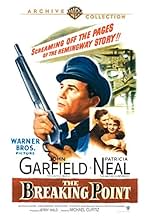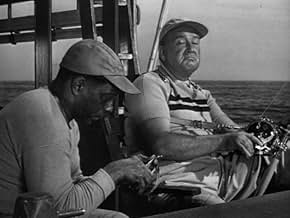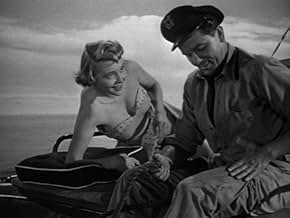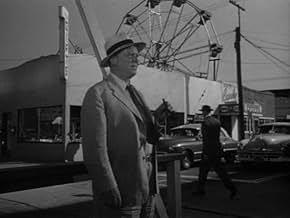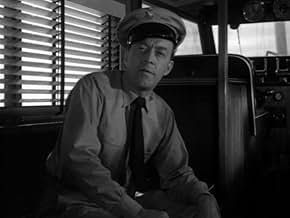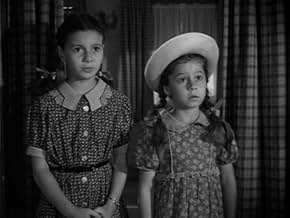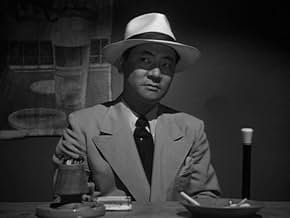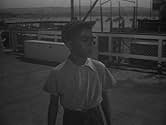Ajouter une intrigue dans votre langueAn otherwise moral captain of a charter boat becomes financially strapped and is drawn into illegal activities in order to keep up payments on his boat.An otherwise moral captain of a charter boat becomes financially strapped and is drawn into illegal activities in order to keep up payments on his boat.An otherwise moral captain of a charter boat becomes financially strapped and is drawn into illegal activities in order to keep up payments on his boat.
- Réalisation
- Scénario
- Casting principal
- Récompenses
- 4 victoires au total
John Alvin
- Reporter
- (non crédité)
Chet Brandenburg
- Taxi Driver
- (non crédité)
Peter Brocco
- Macho
- (non crédité)
Mary Carroll
- Girl at Bar
- (non crédité)
Spencer Chan
- 1st Chinese Immigrant
- (non crédité)
John Close
- Deputy
- (non crédité)
Avis à la une
"The Breaking Point" is technically considered to be a remake of Ernest Hemingway's "To Have and Have Not," first brought to the screen with Bogie and Bacall. But it feels like a whole different story in just about every conceivable way. John Garfield excelled at playing prototypical noir heroes, desperate men doing desperate things when feeling trapped by an unfair fate. This is the role he has here, and watching his character dig himself deeper and deeper into shady doings that he knows are shady from the outset is like watching a slowly unfolding car accident. Patricia Neal is extremely fetching and knows how to deliver a sardonic one liner like no one's business, but the script doesn't do a whole lot with her other than have her appear here and there as window dressing. The stand out for me was Phyllis Thaxter as Garfield's plain Jane wife. It's refreshing in a film from 1950 to see a housewife portrayed as something other than a mindless cipher for her husband's thoughts and desires. Instead, she has a mind of her own and reserves of strength he might not give her credit for.
The most quietly astonishing thing about "The Breaking Point" is its treatment of Garfield's friend and ship assistant, a black man played by Juano Hernandez. The fact that he's black is a complete non-issue in the film. He's treated as an equal by Garfield and his family, and none of the stereotypes about black people that were so prevalent in movies from this time period, even in movies with their hearts in the right places, are present here. The final scene of the film involves this character's son, and it's so striking, and so devastating, that in retrospect the entire film almost seems to be about that scene even though it has almost nothing to do with everything that's come before it.
Michael Curtiz provides the no-frills direction.
Grade: A
The most quietly astonishing thing about "The Breaking Point" is its treatment of Garfield's friend and ship assistant, a black man played by Juano Hernandez. The fact that he's black is a complete non-issue in the film. He's treated as an equal by Garfield and his family, and none of the stereotypes about black people that were so prevalent in movies from this time period, even in movies with their hearts in the right places, are present here. The final scene of the film involves this character's son, and it's so striking, and so devastating, that in retrospect the entire film almost seems to be about that scene even though it has almost nothing to do with everything that's come before it.
Michael Curtiz provides the no-frills direction.
Grade: A
I just saw this movie in the last week at a recent Film Noir Festival here in San Francisco. Garfield owns this role as a down on his luck captain of his boat. He is willing to take shady deals to make money for him and keep his family (his two young daughters) with money. His wife played by Phyllis Thaxter gives a fine turn as a wife and mother. Patricia Neal is smooth and dangerous in her role as a two timing blonde broad. The daughters that played the kids were effective and smart like their ages were depicted. Garfield's mate Wesley Park was very good in his role of Garfiled's suffering partner. The reptilian role of the attorney was convincing and nasty. The final minutes of the movie had me choked up with the performances from Garfield and Thaxter. Another great movie by Michael Curtiz. Why isn't this movie on DVD?
This is a remake of TO HAVE AND HAVE NOT that supposedly from what I've read sticks closer to the Hemingway story. Garfield could play the strong but tormented guy like nobody's business, here however we have most of the information needed in understanding just what's eating at this guy, wearing him down and making him afraid. "A man alone hasn't got a chance," he keeps repeating. But Harry isn't alone. He's got a family that loves him, a plain but good woman he adores, and who adores him. A best friend who is his shipping mate, yet he still can't shake the feeling that somehow the universe is against him, working overtime. He's like a man that needs some spiritual guidance. Something is missing. On first viewing this plays like a well done yarn. On subsequent viewings however, this film begins to haunt. The characters and scenes play on a deeper, more meaningful level. The domestic scenes, usually the throwaway, boring parts of a story like this, become the rock and Garfield and Phylis Thaxter emit genuine emotion and affection for one another that is unusually realistic. Patricia Neal is the temptress here, and in an unusual move, we're not supposed to fall in love with her or maybe even like her, which is evident in how she's physically presented. Her haircut is really bad and she's basically unflatteringly lit and photographed. She too looks realistic: like a once beautiful creature who's been around the block too many times and is starting to look all used up.
Juano Hernandez rounds out the main players as Garfield's friend and shipmate. It was Garfield who insisted the character be a black man and had the relationship between the two beefed up. According to Garfield's daughter, the studio didn't like the idea and tried to talk him out of it, eventually giving up. This casting led to someone (director Michael Curtiz?)coming up with that final shot in the film that hits like a sucker punch to the gut, unexpected and unforgettable.
Watch this one a second time and see if you agree.
Juano Hernandez rounds out the main players as Garfield's friend and shipmate. It was Garfield who insisted the character be a black man and had the relationship between the two beefed up. According to Garfield's daughter, the studio didn't like the idea and tried to talk him out of it, eventually giving up. This casting led to someone (director Michael Curtiz?)coming up with that final shot in the film that hits like a sucker punch to the gut, unexpected and unforgettable.
Watch this one a second time and see if you agree.
... He is the same guy as always, struggling against odds, railing about making it, etc., but toned down a bit. He takes umbrage but there is a restraint that is not present in his earlier more angry-young-man roles. Maybe because he looks as little filled out and older and is a family man to boot. There is a relative maturity in the character that is appealing. Despite playing the proverbial "same role" as some actors are thought of as doing, there is no sense that he is phoning it in. And he holds up more effective than ever with the ultimate no-nonsense imperative of tough guys. Tough but regular too, I like the opening sally, i.e., to the effect that when out to sea a certain tranquillity can reign but back on land nothing but trouble. I like that, especially with the ultimate irony to come.
The domestic scenes are not Hemingway, but added for the movie. A wonderful decision. It rounds out Garfield's character giving him a softer side and allows for the domestic sweetness and wholesome prettiness of Phyllis Thaxter to be his wife. I like to feel that her all-to-obvious new hairdo was not lost on her husband and that it might have helped him decide on another matter regarding a certain lady.
Garfield's remark to his 10-year-old daughter about being "too old to run around (the house) like that" (i.e., in night clothes) was a surprising but effective slice-of-life detail that perhaps only in a small way ushers in the new 50s sensibility regarding such matters that will make films more frank and real with youth (teens) issues.
Patricia Neal is stunning as the would-be femme fatale, - would-be because she falls short of treachery. Her worldly manner and sophisticated beauty provides a stark contrast to Garfield's women in the story. She wants to seduce, and pending the outcome, have the goods on him for revenge. Is she too sympathetic for this? Up in the air,,pending definitions. Reliable veteran character actor Wallace Ford has a good gig as a low-level conduit to the underworld. He has good dialogue, pushy and sarcastic with his own clients but totally subservient when around the big boys. A happy addition to the story. The poor boy alone on the pier resonates and is discomforting.
The domestic scenes are not Hemingway, but added for the movie. A wonderful decision. It rounds out Garfield's character giving him a softer side and allows for the domestic sweetness and wholesome prettiness of Phyllis Thaxter to be his wife. I like to feel that her all-to-obvious new hairdo was not lost on her husband and that it might have helped him decide on another matter regarding a certain lady.
Garfield's remark to his 10-year-old daughter about being "too old to run around (the house) like that" (i.e., in night clothes) was a surprising but effective slice-of-life detail that perhaps only in a small way ushers in the new 50s sensibility regarding such matters that will make films more frank and real with youth (teens) issues.
Patricia Neal is stunning as the would-be femme fatale, - would-be because she falls short of treachery. Her worldly manner and sophisticated beauty provides a stark contrast to Garfield's women in the story. She wants to seduce, and pending the outcome, have the goods on him for revenge. Is she too sympathetic for this? Up in the air,,pending definitions. Reliable veteran character actor Wallace Ford has a good gig as a low-level conduit to the underworld. He has good dialogue, pushy and sarcastic with his own clients but totally subservient when around the big boys. A happy addition to the story. The poor boy alone on the pier resonates and is discomforting.
No one played the haunted/hunted character better than John Garfield (Humphrey Bogart is a close second). Here, Garfield is a boat captain that gets in way over his head. The thing with Garfield's characters, is that even though the audience sympathizes with his plight, the character always brings it on himself. With Garfield's usual acerbic delivery, his Harry Morgan is hard to like but when he is with his family, one sees that he is basically a headstrong but good guy. Even though Michael Curtiz directed this, the tone and especially the ending shot kept reminding me of Fritz Lang. I think this film should be commended for the ending, which although a somewhat happy one, reminds the audience of the affect of one's actions on everyone. This generally was ignored in a lot of the crime dramas from the 30's to the 60's. My only complaint is the Patricia Neal character seemed tacked on for romance sake. She didn't add much and certainly didn't have an impact on the main thrust of the story. But that is a minor quibble. Another gem for one of the move overlooked actors - John Garfield.
Le saviez-vous
- AnecdotesAccording to TCM's Eddie Muller, John Garfield thought this was his best performance and that it was the film of which he was most proud.
- GaffesWhen she first steps onto the boat, Patricia Neal's voice is heard saying "we're off to sunny Mexico," but her lips aren't moving.
- Citations
Harry Morgan: You know, my wife dyed her hair.
Leona Charles: Coincidentally I've been thinking of letting mine grow out. Speaking of coincidences, I live in Number Seven. My friends just kick the door open.
- Crédits fousTHE END close out. All lettering aligned and centered except for the line beneath Warner Bros. that begins PICTURES. It's left registered with whatever wording that followed it 'air brushed' over using the lower right drop shadow pattern leaving a Warner Bros. Pictures _?_?_?_?_ mystery.
- ConnexionsFeatured in The John Garfield Story (2003)
- Bandes originalesPlease Don't Talk About Me When I'm Gone
(uncredited)
Music by Sam H. Stept
Lyrics by Sidney Clare
Sung by Patricia Neal in the bar
Meilleurs choix
Connectez-vous pour évaluer et suivre la liste de favoris afin de recevoir des recommandations personnalisées
- How long is The Breaking Point?Alimenté par Alexa
Détails
- Durée
- 1h 37min(97 min)
- Couleur
- Rapport de forme
- 1.33 : 1
Contribuer à cette page
Suggérer une modification ou ajouter du contenu manquant



